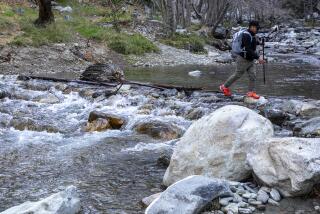Wide Views From a Hole in the Wall
- Share via
Hole-in-the-Wall is an inviting locale, the kind of place Butch Cassidy and the Sundance Kid would have chosen as a hide-out. Its fine camping area, outstanding views of the surrounding mountains and unforgettable hiking attract visitors.
Directly east of the campground are the Woods Mountains. The range features the appropriately named Rustlers Canyon, an out-of-the-way place where cattle rustlers and various outlaws once hid from lawmen.
Although the location of the small campground at Hole-in-the-Wall (elevation 4,200 feet) is pleasant enough to attract campers, bird-watchers and others who just want to “stay put,” more adventurous types find the highlight of a trip to Hole-in-the-Wall is exploring the wondrous volcanic formations that create its backdrop. Visit the Information Center (which is not regularly staffed) at the campground.
Immediately west of the campground is a maze of volcanic rocks that descend first into Banshee Canyon, then into a large, open desert box canyon named Wildhorse Canyon. The two canyons couldn’t be more dissimilar. They provide the visitor with a glimpse of the diversity of Mojave National Preserve. Hikers once used ropes and ladders to descend into Banshee Canyon from the campground area; today, the descent is accomplished by negotiating two sets of iron rings that have been set into the rock. Maneuvering through the rings is not particularly difficult for those who are reasonably agile and take their time. But acrophobes or claustrophobes may want to skip this adventure.
The story about the naming of Hole-in-the-Wall is easy to envision as you encounter the twisted maze of red rock. As the legend goes, in the 1880s, a couple of ranch hands from nearby Dominguez Ranch were searching for some stray cattle, and they came upon a pair of Indians who were leading a few cattle. Suspecting them of stealing their stock, the ranch hands chased the Indians into a canyon, which they thought was a dead end. To their amazement, the Indians scrambled up the rocks in the lower canyon and then disappeared--seemingly right into the blank wall. The men concluded the Indians must have found or created a hole in the wall.
You can enjoy exploring the volcanic rock formations known as rhyolite, a crystallized form of lava. The holes provide frames for taking silly photographs. You might spot any number of raptors circling overhead: golden eagles, hawks and owls.
Hole-in-the-Wall rocks have a violent past, geologically speaking. About 18 million years ago, a volcano in the Woods Mountains erupted and spewed ash and rocks. Hot ashes cremated every living thing in the area; countless plant and animal fossils lie entombed beneath the volcanic tuff of Hole-in-the-Wall’s cliffs.
Directions to trail head: From Interstate 40, about 42 miles west of Needles and nearly 100 miles east of Barstow, exit on Essex Road. Head north 9.5 miles to the junction of Essex Road and Black Canyon Road. Bear right on the latter road, which soon turns to dirt. (Well-graded Black Canyon Road is suitable for passenger cars.) After 8.5 miles of travel, you’ll spot Hole-in-the-Wall Campground on your left. Follow the dirt road past the visitor center to the parking area at the picnic ground.
The hike: The path plunges into a wall of rocks. Grasp the iron rings and lower yourself into Banshee Canyon. Descend amid the impressive pock-marked canyon walls. You can turn around at the canyon bottom or continue as your route curves north toward Wild Horse Canyon. Hole-in-the-Wall is not the only place in this area with a colorful name. Banshee is named not for the shrieking spirits of the Scottish Highlands, but for the sounds said to be heard here at night that resemble their cries. Horned owls and the sound of the wind whistling through the holes make a quiet night in the canyon unlikely.
Follow Banshee to its opening, then turn north, follow the wash and pick your way cross-country to the indistinct trail leading northward. The trail climbs gently onto a low mesa that offers good views of Wild Horse Mesa to the left, and desert varnish-covered rock formations on the right.
Continue northward through a magnificent devil’s garden filled with yucca, cholla, beavertail, barrel cactus and prickly pear. In the springtime, the cactus bloom spreads bright yellow and hot pink across the canyon. As you near the end of the canyon, enjoy the view of the juniper-filled basin to the north, the mountains and mesas in every direction. If you continued northward, you would reach Mid Hills, eight miles away by the preserve’s longest maintained trail.
For more of John McKinney’s hiking tips and trails, visit Internet https://www.thetrailmaster.com.
(BEGIN TEXT OF INFOBOX / INFOGRAPHIC)
Hole-in-the-Wall Trail WHERE: Mojave National Preserve
DISTANCE: From Campground to Hole-in-the-Wall is 2 miles round trip; longer options possible, including 16 miles round trip to Mid Hills Campground.
TERRAIN: Desert box canyon, maze of volcanic rocks.
HIGHLIGHTS: Descent via iron rings into canyon, holes in the canyon walls.
DEGREE OF DIFFICULTY: Easy except for the ring descent.
PRECAUTIONS: Slowly, carefully on the ring descent.
FOR MORE INFORMATION: Mojave National Preserve, tel. (760) 255-8801; Mojave Desert Baker Information Center, 72157 Baker Blvd., Baker, tel. (760) 733-4040.
More to Read
Sign up for The Wild
We’ll help you find the best places to hike, bike and run, as well as the perfect silent spots for meditation and yoga.
You may occasionally receive promotional content from the Los Angeles Times.






